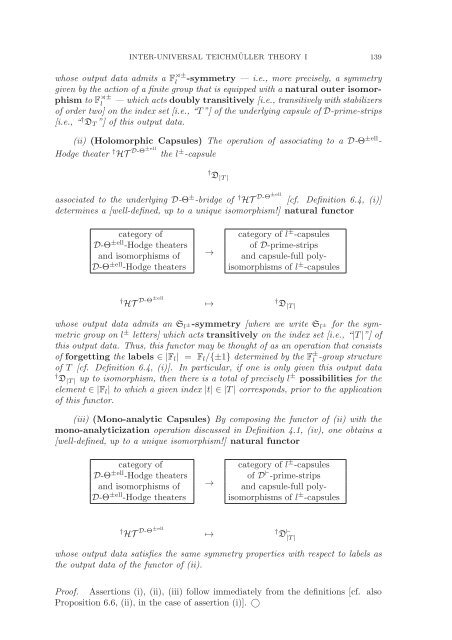Inter-universal Teichmuller Theory I: Construction of Hodge Theaters
Inter-universal Teichmuller Theory I: Construction of Hodge Theaters
Inter-universal Teichmuller Theory I: Construction of Hodge Theaters
Create successful ePaper yourself
Turn your PDF publications into a flip-book with our unique Google optimized e-Paper software.
INTER-UNIVERSAL TEICHMÜLLER THEORY I 139<br />
whose output data admits a F ⋊±<br />
l<br />
-symmetry — i.e., more precisely, a symmetry<br />
given by the action <strong>of</strong> a finite group that is equipped with a natural outer isomorphism<br />
to F ⋊±<br />
l<br />
— which acts doubly transitively [i.e., transitively with stabilizers<br />
<strong>of</strong> order two] on the index set [i.e., “T ”] <strong>of</strong> the underlying capsule <strong>of</strong> D-prime-strips<br />
[i.e., “ † D T ”] <strong>of</strong> this output data.<br />
(ii) (Holomorphic Capsules) The operation <strong>of</strong> associating to a D-Θ ±ell -<br />
<strong>Hodge</strong> theater † HT D-Θ±ell<br />
the l ± -capsule<br />
† D |T |<br />
associated to the underlying D-Θ ± -bridge <strong>of</strong> † HT D-Θ±ell<br />
[cf. Definition 6.4, (i)]<br />
determines a [well-defined, up to a unique isomorphism!] natural functor<br />
category <strong>of</strong><br />
D-Θ ±ell -<strong>Hodge</strong> theaters<br />
and isomorphisms <strong>of</strong><br />
D-Θ ±ell -<strong>Hodge</strong> theaters<br />
→<br />
category <strong>of</strong> l ± -capsules<br />
<strong>of</strong> D-prime-strips<br />
and capsule-full polyisomorphisms<br />
<strong>of</strong> l ± -capsules<br />
† HT D-Θ±ell ↦→ † D |T |<br />
whose output data admits an S l ±-symmetry [where we write S l<br />
± for the symmetric<br />
group on l ± letters] which acts transitively on the index set [i.e., “|T |”] <strong>of</strong><br />
this output data. Thus, this functor may be thought <strong>of</strong> as an operation that consists<br />
<strong>of</strong> forgetting the labels ∈|F l | = F l /{±1} determined by the F ± l<br />
-group structure<br />
<strong>of</strong> T [cf. Definition 6.4, (i)]. In particular, if one is only given this output data<br />
† D |T | up to isomorphism, then there is a total <strong>of</strong> precisely l ± possibilities for the<br />
element ∈|F l | to which a given index |t| ∈|T | corresponds, prior to the application<br />
<strong>of</strong> this functor.<br />
(iii) (Mono-analytic Capsules) By composing the functor <strong>of</strong> (ii) with the<br />
mono-analyticization operation discussed in Definition 4.1, (iv), one obtains a<br />
[well-defined, up to a unique isomorphism!] natural functor<br />
category <strong>of</strong><br />
D-Θ ±ell -<strong>Hodge</strong> theaters<br />
and isomorphisms <strong>of</strong><br />
D-Θ ±ell -<strong>Hodge</strong> theaters<br />
→<br />
category <strong>of</strong> l ± -capsules<br />
<strong>of</strong> D ⊢ -prime-strips<br />
and capsule-full polyisomorphisms<br />
<strong>of</strong> l ± -capsules<br />
† HT D-Θ±ell ↦→ † D ⊢ |T |<br />
whose output data satisfies the same symmetry properties with respect to labels as<br />
the output data <strong>of</strong> the functor <strong>of</strong> (ii).<br />
Pro<strong>of</strong>. Assertions (i), (ii), (iii) follow immediately from the definitions [cf. also<br />
Proposition 6.6, (ii), in the case <strong>of</strong> assertion (i)]. ○
















